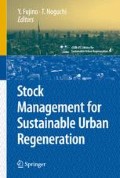Steel structures are predominant in building construction in Japan. As shown in Fig. 8-1, steel structures increased rapidly after World War II and at present account for about 40% of the total floor areas of newly constructed buildings in a year. This ratio is comparable with wooden structures, while concrete structures are limited to about 20%. Such a high share of steel in building construction is unique in the world. The reason why steel buildings are so popular in Japan may be found in the strong support the government gave to developing the steel industry soon after the Meiji Restoration. The policy invited an extraordinary advancement of the technology of applying steel materials to various industrial products. At the same time, however, another important factor cannot be neglected: Japan is an earthquake-prone country located in one of the most quake-hazardous regions on Earth. Thus, the basic idea of structural design has been established: that strong and tough materials should be used in building structures to resist the impact of severe earthquakes. Obviously, steel is the best material to fit such requirements. Although steel is more expensive than concrete and timber, the practice of employing it in buildings has been sustained by the national wealth of Japan
Access this chapter
Tax calculation will be finalised at checkout
Purchases are for personal use only
Preview
Unable to display preview. Download preview PDF.
References
Architectural Institute of Japan (1997) Report on the Hanshin-Awaji Earthquake Disaster, Building Series Vol 3, Structural Damage to Steel Buildings, Maruzen
Architectural Institute of Japan (2000) Tentative Provisions for Brittle Fracture of Steel Buildings, Proceedings of Panel Discussion: 9.
Department of Architecture, School of Engineering, the University of Tokyo (2005) Report on Seismic Retrofitting of Building No 11 of School of Engineering: 3
Iwata, Y., Sugimoto, H. and Kuwamura, H. (2005) Reparability Limit of Steel Structural Buildings. Journal of Structural and Construction Engineering (Transactions of AIJ) 588(2): 165–172
Kuwamura, H. (2002) Performance and Design of Steel Structures. 1.2 History of Iron and Steel Structures, 11.10 Welding and Earthquake Damage, Kyoritsu-Shuppan
Kuwamura, H. (2003) Classification of Material and Welding in Fracture Consideration of Seismic Steel Frames, Engineering Structures. Journal of Earthquake, Wind and Ocean Engineering 25(5): 547–563
Kuwamura, H. and Sasaki, M. (1990) Control of Random Yield-Strength for Mechanism-Based Seismic Design. Journal of Structural Engineering, ASCE 116(1): 98–110
Kuwamura Lab (1995) Field Survey Report on 1995 Hyogoken-Nambu Earthquake Disaster
Kuwamura, H., Tanaka, N., Sugimoto, H. and Kouno, T. (2002) Performance Description of Steel Structures. Journal of Structural and Construction Engineering 562(12): 175–182.
Ministry of Construction (2002) Concept of Performance-Based Design of Building Structures, Gihodo-Shuppan
SAC Joint Venture (2000) Recommended Seismic Design Criteria for New Steel Moment-Frame Buildings, FEMA-350, Chap 2 General Requirements, Chap 4 Performance Evaluation
Structural Engineers Association of California (SEAOC) (1995) Sacramento, CA: Vision 2000 Committee: Performance Based Seismic Engineering of Buildings, Sacramento, CA
Usami, B. (2006) Guideline for Seismic and Damage Control Design of Steel Bridges, Gihodo-Shuppan
Author information
Authors and Affiliations
Editor information
Editors and Affiliations
Rights and permissions
Copyright information
© 2009 Springer Science+Business Media
About this chapter
Cite this chapter
Kuwamura, H. (2009). Earthquake-Resistant Engineering of Steel Structures. In: Fujino, Y., Noguchi, T. (eds) Stock Management for Sustainable Urban Regeneration. cSUR-UT Series: Library for Sustainable Urban Regeneration, vol 4. Springer, Tokyo. https://doi.org/10.1007/978-4-431-74093-3_8
Download citation
DOI: https://doi.org/10.1007/978-4-431-74093-3_8
Publisher Name: Springer, Tokyo
Print ISBN: 978-4-431-74092-6
Online ISBN: 978-4-431-74093-3
eBook Packages: Earth and Environmental ScienceEarth and Environmental Science (R0)

